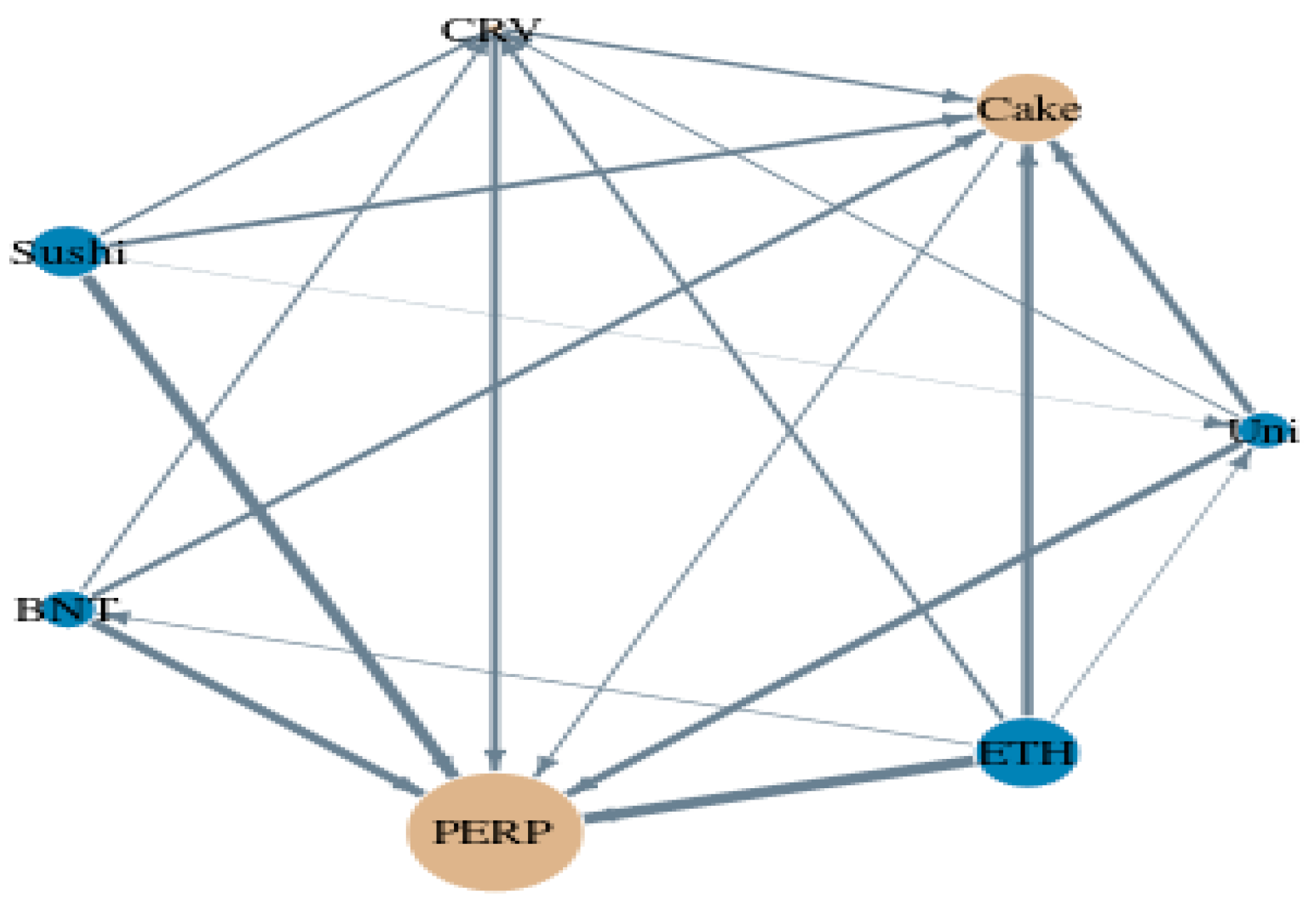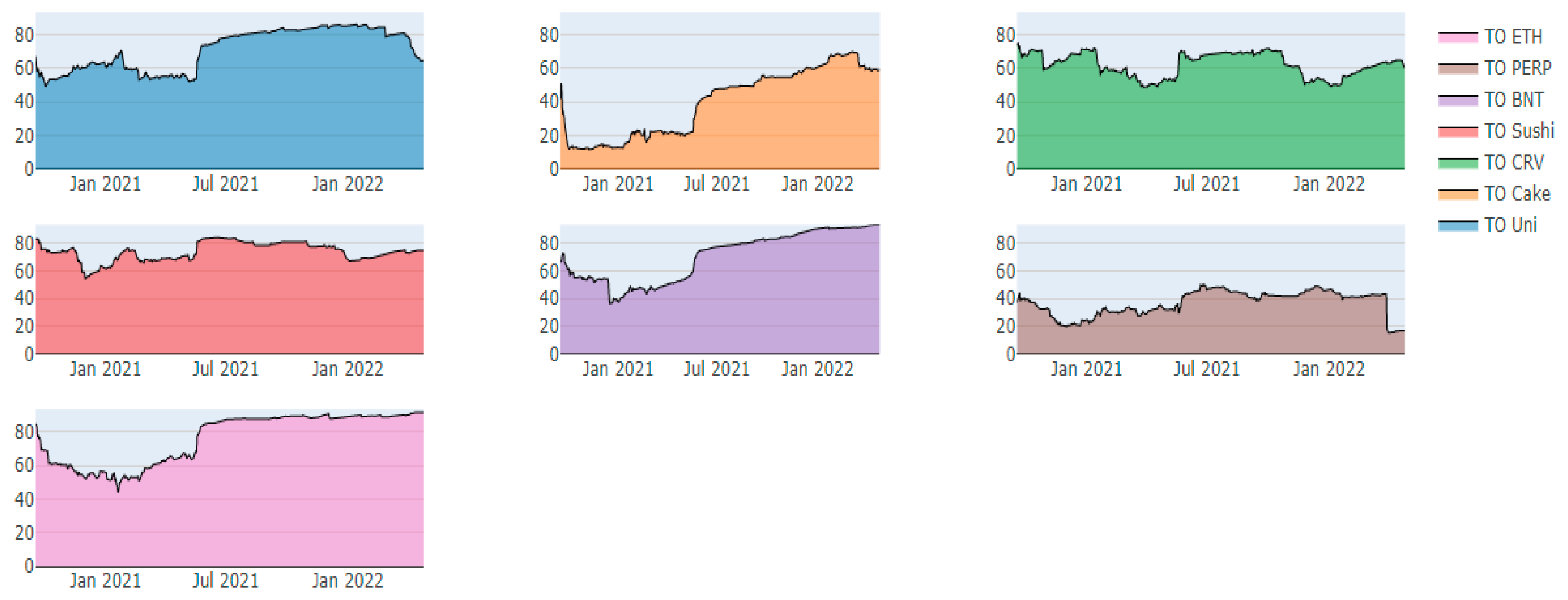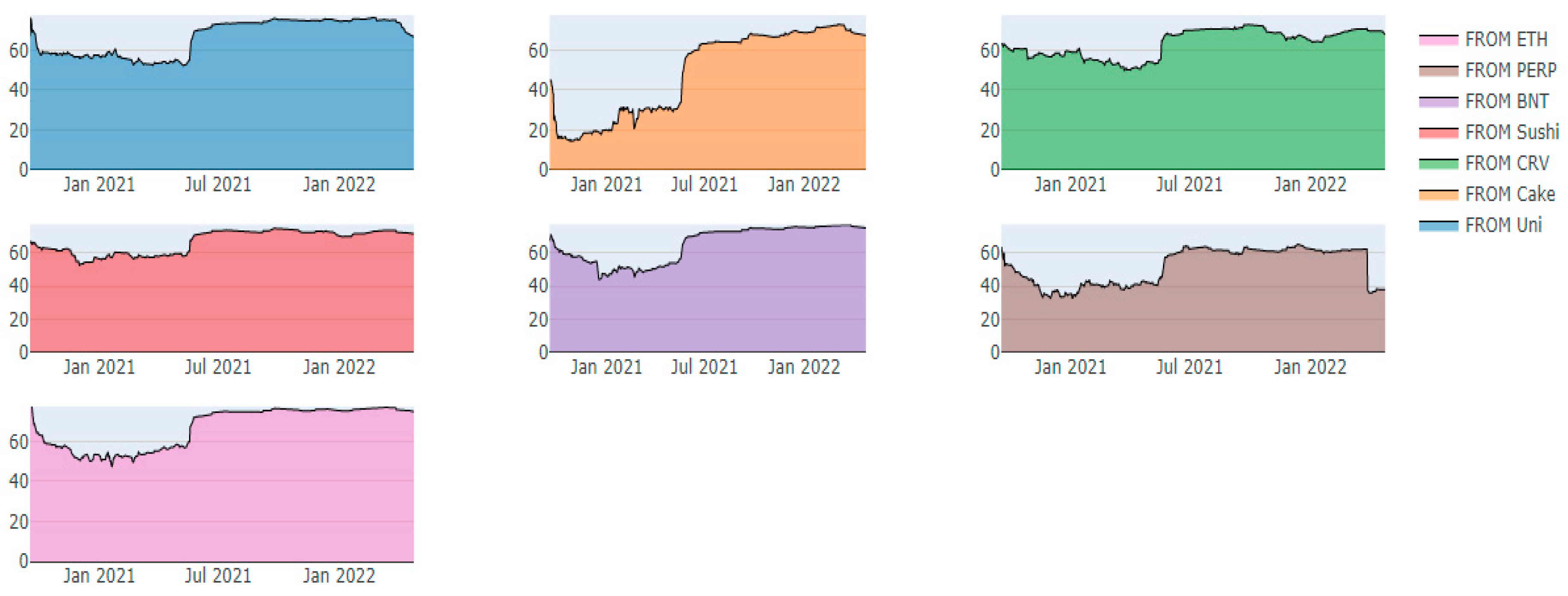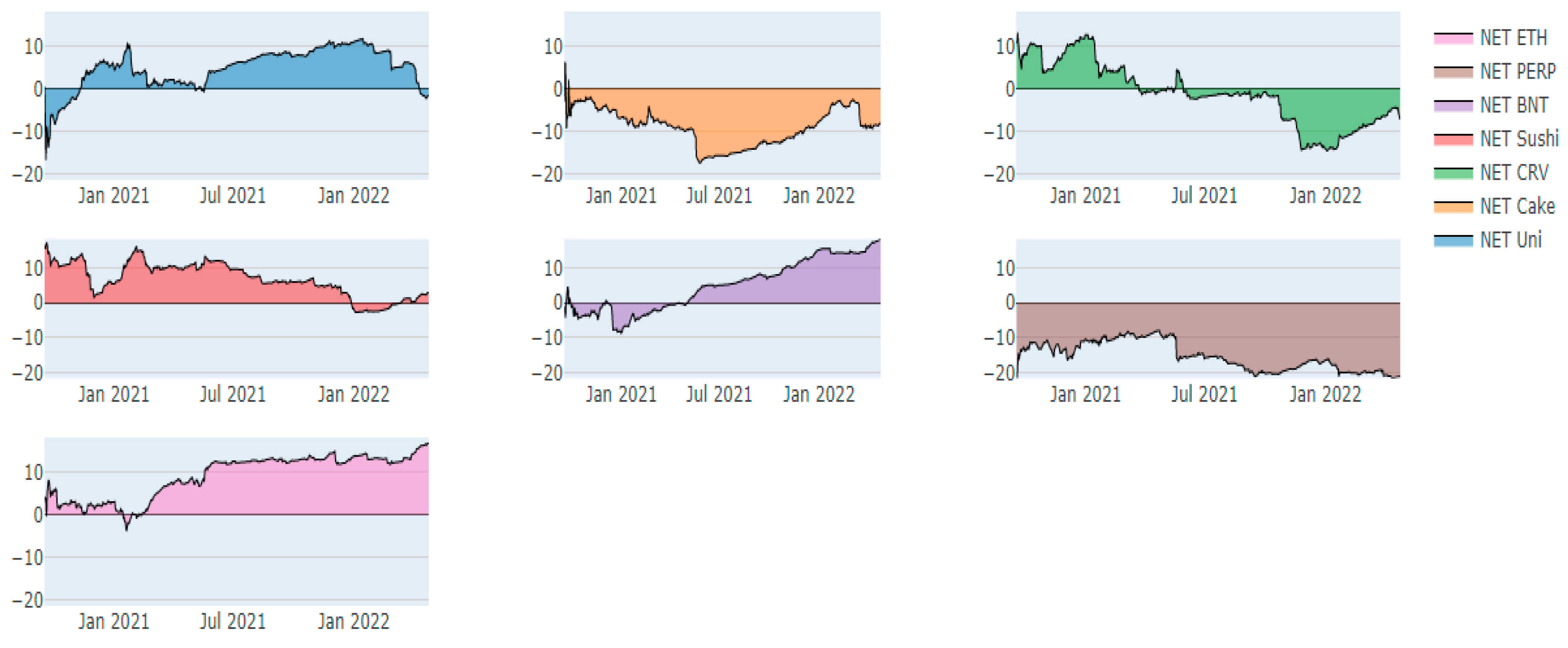Do Automated Market Makers in DeFi Ecosystem Exhibit Time-Varying Connectedness during Stressed Events?
Abstract
1. Introduction
2. Research Methodology
2.1. TVP-VAR
2.2. Data Details
3. Results and Interpretation
3.1. Average Connectedness
3.2. Time-Varying Connectedness
4. Discussion
5. Conclusions
6. Limitations and Scope for Future Studies
Author Contributions
Funding
Data Availability Statement
Conflicts of Interest
| 1 | |
| 2 | |
| 3 | The stationary time series may be divided into two components using the wold theorem. The first component is deterministic and can be represented by a linear combination of deterministic functions such as polynomials, trigonometric functions, and so on. The second component is stochastic, and it is represented as a weighted sum of innovations, which are i.i.d random variables with finite variance. |
| 4 | https://www.coingecko.com/en/coins/, accessed on 1 May 2022. |
| 5 | https://www.economist.com/finance-and-economics/the-race-to-power-the-defi-ecosystem-is-on/21807229, accessed on 1 May 2022. |
| 6 | https://finance.yahoo.com/news/ethereum-binance-smart-chain-blockchain-defi-crypto-074504608.html, accessed on 1 May 2022. |
| 7 | https://www.binance.com/en/fee/cryptoFee, accessed on 1 May 2022. |
| 8 | https://coinremitter.com/fees, accessed on 1 May 2022. |
References
- Abdulhakeem, Saif Ahmed, and Qiuling Hu. 2021. Powered by Blockchain technology, DeFi (decentralized finance) strives to increase financial inclusion of the unbanked by reshaping the world financial system. Modern Economy 12: 1–16. [Google Scholar] [CrossRef]
- Allen, Franklin, and Douglas Gale. 2000. Financial Contagion. Journal of Political Economy 108: 1–33. [Google Scholar] [CrossRef]
- Angeris, Guillermo, Hsien-Tang Kao, Rei Chiang, Charlie Noyes, and Tarun Chitra. 2020. An Analysis of Uniswap markets. Cryptoeconomic Systems 1: 1–30. [Google Scholar] [CrossRef]
- Antonakakis, Nikolaos, David Gabauer, Rangan Gupta, and Vasilios Plakandaras. 2018. Dynamic connectedness of uncertainty across developed economies: A time-varying approach. Economics Letters 166: 63–75. [Google Scholar] [CrossRef]
- Antonakakis, Nikolaos, Ioannis Chatziantoniou, and David Gabauer. 2020. Refined Measures of Dynamic Connectedness based on Time-Varying Parameter Vector Autoregressions. Journal of Risk and Financial Management 13: 84. [Google Scholar] [CrossRef]
- Aramonte, Sirio, Wenqian Huang, and Andreas Schrimpf. 2021. Trading in the DeFi Era: Automated Market-Maker. BIS Quarterly Review. Available online: https://www.bis.org/publ/qtrpdf/r_qt2112v.htm (accessed on 1 May 2022).
- Bartoletti, Massimo, James Hsin-Yu Chiang, and Alberto Lluch-Lafuente. 2021. A Theory of Automated Market Makers in DeFi. Lecture Notes in Computer Science (Including Subseries Lecture Notes in Artificial Intelligence and Lecture Notes in Bioinformatics). Cham: Springer, vol. 12717, pp. 168–87. [Google Scholar] [CrossRef]
- Benlagha, Noureddine, and Salaheddine El Omari. 2022. Connectedness of stock markets with gold and oil: New evidence from COVID-19 pandemic. Finance Research Letters 46: 102373. [Google Scholar] [CrossRef]
- Bouri, Elie, Saeed Tareq, Xuan Vinh Vo, and David Roubaud. 2021. Quantile connectedness in the cryptocurrency market. Journal of International Financial Markets, Institutions and Money 71: 101302. [Google Scholar] [CrossRef]
- Chen, Jiachi, Xin Xia, David Lo, John Grundy, and Xiaohu Yang. 2021. Maintenance-related concerns for post-deployed Ethereum smart contract development: Issues, techniques, and future challenges. Empirical Software Engineering 6. Available online: https://www.springerprofessional.de/en/maintenance-related-concerns-for-post-deployed-ethereum-smart-co/19599936 (accessed on 1 May 2022). [CrossRef]
- Chohan, Usman. 2021. Decentralized Finance (DeFi): An Emergent Alternative Financial Architecture. Critical Blockchain Research Initiative (CBRI) Working Papers. Available online: https://ssrn.com/abstract=3791921 (accessed on 1 May 2022). [CrossRef]
- Corbet, Shaen, John W. Goodell, John W. Goodell, and Kerem Kaskaloglu. 2021. Are DeFi Tokens a Separate Asset Class from Conventional Cryptocurrencies? Annals of Operations Research 322: 609–30. Available online: https://ssrn.com/abstract=3810599 (accessed on 1 May 2022). [CrossRef]
- Diebold, Francis X., and Kamil Yilmaz. 2012. Better to give than to receive: Predictive directional measurement of volatility spillovers. International Journal of Forecasting 28: 57–66. [Google Scholar] [CrossRef]
- Diebold, Francis X., and Kamil Yilmaz. 2014. On the network topology of variance decompositions: Measuring the connectedness of financial firms. Journal of Econometrics 182: 119–34. [Google Scholar] [CrossRef]
- Fuentes, Fernanda, and Rodrigo Herrera. 2020. Dynamics of connectedness in clean energy stocks. Energies 13: 3705. [Google Scholar] [CrossRef]
- Gubareva, Mariya. 2021. Lower reversal limit of the European Central Bank deposit rate and sustainability of traditional banking business model. Journal of Financial Economic Policy 13: 686–97. [Google Scholar] [CrossRef]
- Hacker, R. Scott, and Hatemi-J. Abdulnasser. 2006. Tests for causality between integrated variables using asymptotic and bootstrap distributions: Theory and application. Applied Economics 38: 1489–500. [Google Scholar] [CrossRef]
- Jensen, Johannes Rude, Mohsen Pourpouneh, Kurt Nielsen, and Omri Ross. 2021. The Homogeneous Properties of Automated Market Makers. SSRN Electronic Journal 131: 1–17. [Google Scholar] [CrossRef]
- Johnstone, Syren. 2020. Secondary markets in digital assets: Rethinking regulatory policy in centralized and decentralized environments. Stanford Journal of Blockchain Law & Policy 3: 146–88. Available online: https://stanford-jblp.pubpub.org/pub/secondary-markets-digital-assets/release/2 (accessed on 1 May 2022).
- Karim, Sitara, Brian M. Lucey, Muhammad Abubakr Naeem, and Gazi Salah Uddin. 2022. Examining the Interrelatedness of NFTs, DeFi Tokens and Cryptocurrencies. Finance Research Letters 47: 102696. [Google Scholar] [CrossRef]
- Katsiampa, Paraskevi, Larisa Yarovaya, and Damian Zięba. 2021. High-Frequency Connectedness between Bitcoin and Other Top-Traded Crypto Assets during the COVID-19 Crisis. Journal of International Financial Markets, Institutions and Money 79: 101578. [Google Scholar] [CrossRef]
- Koop, Gary, M. Hashem Pesaran, and Simon M. Potter. 1996. Impulse response analysis in nonlinear multivariate models. Journal of Econometrics 74: 119–47. [Google Scholar] [CrossRef]
- Lin, Lindsay X. 2019. Deconstructing decentralized exchanges. Stanford Journal of Blockchain Law & Policy 2: 58–77. Available online: https://stanford-jblp.pubpub.org/pub/deconstructing-dex/release/1 (accessed on 1 May 2022).
- Liu, Yulin, Yuxuan Lu, Kartik Nayak, Fan Zhang, Luyao Zhang, and Yinhong Zhao. 2022. Empirical Analysis of EIP-1559: Transaction Fees, Waiting Time, and Consensus Security. arXiv arXiv:2201.0557. [Google Scholar]
- Marecki, Krzysztof, and Agnieszka Wójcik-Czerniawska. 2021. Defi (decentralized finance) will Lead to a revolution in the world of financial services. Economy & Business Journal 15: 284–90. [Google Scholar]
- Mohan, Vijay. 2022. Automated market makers and decentralized exchanges: A DeFi primer. Financial Innovation 8: 1–48. [Google Scholar] [CrossRef]
- Negara, Edi Surya, Achmad Nizar Hidayanto, Ria Andryani, and Rezki Syaputra. 2021. Survey of smart contract framework and its application. Information 12: 257. [Google Scholar] [CrossRef]
- Pesaran, H. Hashem, and Yongcheol Shin. 1998. Generalized impulse response analysis in linear multivariate models. Economics Letters 58: 17–29. [Google Scholar] [CrossRef]
- Pourpouneh, Mohsen, Kurt Nielsen, and O. Ross. 2020. Available online: www.econstor.eu (accessed on 1 August 2020).
- Schär, Fabian. 2021. Decentralized finance: On Blockchain- and smart contract-based financial markets. Federal Reserve Bank of St. Louis Review 103: 153–74. [Google Scholar] [CrossRef]
- Umar, Zaghum, Dimitris Kenourgios, and Sypros Papathanasiou. 2020. The static and dynamic connectedness of environmental, social, and governance investments: International evidence. Economic Modelling 93: 112–24. [Google Scholar] [CrossRef] [PubMed]
- Vos, M. A. 2021. Decentralization and Disintermediation in Blockchain-Based Marketplaces. Ph.D. thesis, Delft University of Technology, Delft, The Netherlands. [Google Scholar] [CrossRef]
- Wang, Yongge. 2020. Automated Market Makers for Decentralized Finance (DeFi). arXiv arXiv:2009.0167. [Google Scholar]
- Werner, Sam, Daniel Perez, Lewis Gudgeon, Ariah Klages-Mundt, Dominik Harz, and William J. Knottenbelt. 2021. SoK: Decentralized Finance (DeFi). Available online: https://arxiv.org/pdf/2101.08778.pdf (accessed on 1 May 2022).
- Xu, Jiahua, and Nikhil Vadgama. 2021. From banks to DeFi: The evolution of the lending market. arXiv arXiv:2104.00970. [Google Scholar]
- Xu, Jiahua, Krzysztof Paruc, Simon Cousaer, and Yebo Feng. 2021. SoK: Decentralized Exchanges (DEX) with Automated Market Maker (AMM) Protocols. arXiv arXiv:2103.12732. [Google Scholar] [CrossRef]
- Yousaf, Imran, and Larisa Yarovaya. 2021. Static and Dynamic Connectedness between NFTs, Defi and other Assets: Portfolio Implication. Available online: https://ssrn.com/abstract=3946611 (accessed on 1 May 2022).
- Zetzsche, Dirk A., Douglas W. Arner, and Ross P. Buckley. 2020. Decentralised finance. Journal of Financial Regulation 6: 172–203. [Google Scholar] [CrossRef]






| AMM Name | AMM Code | Smart Contract | Running on |
|---|---|---|---|
| Uniswap | Uni | V3 | Ethereum |
| Pancake | Cake | V2 | Binance |
| Perpetual protocol | PERP | V2 | Ethereum |
| Curve Dao | CRV | ERC20 | Ethereum |
| Bancor Network | BNT | ERC20 | Ethereum |
| SushiSwap | Sushi | MasterChef | Ethereum |
| Uni | Cake | CRV | Sushi | BNT | PERP | ETH | |
|---|---|---|---|---|---|---|---|
| Mean | 0.001 | 0.004 | 0.001 | 0.001 | 0.001 | 0.001 | 0.004 |
| Variance | 0.006 | 0.011 | 0.008 | 0.007 | 0.004 | 0.007 | 0.003 |
| Skewness | 1.527 *** | −1.262 *** | 0.052 | 0.037 | 0.519 *** | 0.039 | −0.441 *** |
| 0 | 0 | −0.604 | −0.708 | 0 | −0.694 | 0 | |
| Kurtosis | 14.676 *** | 20.980 *** | 4.282 *** | 2.616 *** | 4.644 *** | 5.736 *** | 4.657 *** |
| 0 | 0 | 0 | 0 | 0 | 0 | 0 | |
| JB | 5486.7 *** | 10903.1 *** | 448.02 *** | 167.2 *** | 552.8 *** | 803.4 *** | 548.4 *** |
| 0 | 0 | 0 | 0 | 0 | 0 | 0 | |
| ERS | −11.714 *** | −2.947 *** | −8.740 *** | −11.19 *** | −9.718 *** | −3.101 *** | −4.094 *** |
| 0 | −0.003 | 0 | 0 | 0 | −0.002 | 0 | |
| Q (10) | 15.168 *** | 16.932 *** | 2.442 | 21.216 *** | 6.538 | 6.452 | 11.630 ** |
| −0.005 | −0.002 | −0.892 | 0 | −0.302 | −0.311 | −0.032 | |
| Q2(10) | 9.307 * | 136.731 *** | 21.691 *** | 60.940 *** | 47.469 *** | 9.837 * | 46.381 *** |
| −0.096 | 0 | 0 | 0 | 0 | −0.075 | 0 |
| Uni | Cake | CRV | Sushi | BNT | PERP | ETH | FROM | |
|---|---|---|---|---|---|---|---|---|
| Uni | 33.5 | 7.71 | 11.76 | 16.64 | 11.63 | 6.05 | 12.71 | 66.5 |
| Cake | 9.95 | 50.92 | 7.66 | 8.33 | 9.05 | 4.57 | 9.53 | 49.08 |
| CRV | 12.56 | 6.32 | 36.51 | 15.09 | 12.19 | 5.81 | 11.51 | 63.49 |
| Sushi | 16.4 | 6.42 | 13.73 | 32.87 | 11.55 | 6.27 | 12.75 | 67.13 |
| BNT | 11.63 | 7.18 | 11.21 | 11.74 | 34.32 | 6 | 17.92 | 65.68 |
| PERP | 8.6 | 5.43 | 7.74 | 9.5 | 8.92 | 48.01 | 11.8 | 51.99 |
| ETH | 12.16 | 7.01 | 10.13 | 12.56 | 17.3 | 7.97 | 32.87 | 67.13 |
| TO | 71.3 | 40.06 | 62.23 | 73.86 | 70.65 | 36.67 | 76.23 | 430.99 |
| Inc. Own | 104.8 | 90.97 | 98.74 | 106.73 | 104.98 | 84.68 | 109.1 | TCI = 77% |
| NET | 4.8 | −9.03 | −1.26 | 6.73 | 4.98 | −15.32 | 9.1 |
| Date | TCI | Events |
|---|---|---|
| 31 May 2021 | 78% | Delta variant was declared |
| 22 November 2021 | 82% | Delta variant reached over 180 countries |
| 24 November 2021 | 83% | Omicron variant was declared |
| 24 February 2022 | 84% | Russian aggression on Ukraine |
Disclaimer/Publisher’s Note: The statements, opinions and data contained in all publications are solely those of the individual author(s) and contributor(s) and not of MDPI and/or the editor(s). MDPI and/or the editor(s) disclaim responsibility for any injury to people or property resulting from any ideas, methods, instructions or products referred to in the content. |
© 2023 by the authors. Licensee MDPI, Basel, Switzerland. This article is an open access article distributed under the terms and conditions of the Creative Commons Attribution (CC BY) license (https://creativecommons.org/licenses/by/4.0/).
Share and Cite
Ghosh, B.; Kazouz, H.; Umar, Z. Do Automated Market Makers in DeFi Ecosystem Exhibit Time-Varying Connectedness during Stressed Events? J. Risk Financial Manag. 2023, 16, 259. https://doi.org/10.3390/jrfm16050259
Ghosh B, Kazouz H, Umar Z. Do Automated Market Makers in DeFi Ecosystem Exhibit Time-Varying Connectedness during Stressed Events? Journal of Risk and Financial Management. 2023; 16(5):259. https://doi.org/10.3390/jrfm16050259
Chicago/Turabian StyleGhosh, Bikramaditya, Hayfa Kazouz, and Zaghum Umar. 2023. "Do Automated Market Makers in DeFi Ecosystem Exhibit Time-Varying Connectedness during Stressed Events?" Journal of Risk and Financial Management 16, no. 5: 259. https://doi.org/10.3390/jrfm16050259
APA StyleGhosh, B., Kazouz, H., & Umar, Z. (2023). Do Automated Market Makers in DeFi Ecosystem Exhibit Time-Varying Connectedness during Stressed Events? Journal of Risk and Financial Management, 16(5), 259. https://doi.org/10.3390/jrfm16050259








